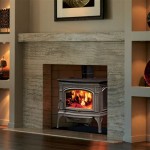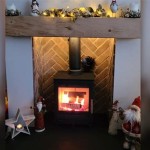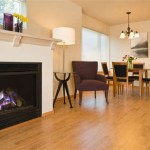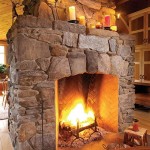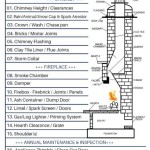Stacked Stone Tiles: Elevating Fireplaces with Texture and Style
Fireplaces serve as focal points in residential and commercial spaces, providing warmth and aesthetic appeal. Stacked stone tiles have emerged as a popular choice for fireplace surrounds due to their ability to introduce texture, depth, and a natural element to interior design. These tiles, characterized by their layered appearance, offer a versatile solution for enhancing the visual interest of any fireplace, irrespective of the style or scale.
The allure of stacked stone tiles lies in their capacity to emulate the look of natural stone without the complexities associated with installing individual stones. This approach streamlines the installation process, reducing both time and cost. The pre-fabricated nature of the tiles ensures a consistent appearance, while the varied textures and colors available cater to a broad range of design preferences. From rustic charm to contemporary elegance, stacked stone tiles can be seamlessly integrated into diverse architectural contexts.
Furthermore, stacked stone tiles are not limited to fireplaces. They can be utilized as accent walls, exterior cladding, or as decorative elements in various interior and exterior applications. Their durability and resistance to environmental factors make them a practical option for both indoor and outdoor settings. This article will explore the benefits, types, installation considerations, and maintenance aspects of stacked stone tiles, providing a comprehensive overview for those considering this material for their fireplaces or other design projects.
Enhancing Aesthetics and Adding Value to Your Property
One of the foremost benefits of using stacked stone tiles for fireplaces is the significant aesthetic enhancement they provide. The layered texture creates visual interest and adds depth to the fireplace surround, transforming it from a simple functional element into a captivating design feature. The natural variation in color and texture within the tiles contributes to a sense of authenticity, mimicking the appearance of a natural stone installation.
The versatility of stacked stone tiles allows for customization to suit various design styles. For a rustic aesthetic, tiles with rough textures and earthy tones can be employed. Conversely, for a more contemporary look, sleek, streamlined tiles with neutral colors can be selected. The ability to tailor the material to specific design preferences ensures that the fireplace seamlessly integrates with the overall aesthetic of the space.
Beyond aesthetics, stacked stone tiles can also increase the perceived value of a property. A well-designed fireplace can serve as a significant selling point, and the addition of stacked stone cladding elevates the perceived quality and sophistication of the home. This is particularly relevant in competitive real estate markets where visual appeal plays a crucial role in attracting potential buyers.
In addition, stacked stone provides a visual anchor in a room. Its substantial presence can balance out other design elements and create a sense of stability and permanence. Whether used as a full floor-to-ceiling surround or as a more subtle accent, stacked stone elevates the fireplace from a mere heat source to a prominent architectural feature.
Types of Stacked Stone and Their Characteristics
Stacked stone tiles are available in a wide variety of materials, colors, and textures, offering a broad range of design possibilities. The selection of the appropriate type of stacked stone depends on factors such as the desired aesthetic, the budget, and the specific application. Understanding the characteristics of different types of stacked stone is essential for making an informed decision.
Natural Stone: As the name suggests, these are constructed from actual stone pieces. They are known for their durability and authenticity. Popular natural stone choices include slate, quartzite, and travertine. Each type of stone imparts a unique texture and color palette. Slate, for instance, typically features darker, more muted tones, while quartzite offers a wider range of colors and a more crystalline texture. Natural stone options are generally more expensive than manufactured alternatives but offer unparalleled beauty and longevity.
Manufactured Stone: These are fabricated using a blend of cement, aggregates, and pigments. Manufactured stone is designed to replicate the appearance of natural stone at a lower cost. It offers several advantages, including lighter weight, easier installation, and greater consistency in color and texture. Manufactured stone is also often more readily available than natural stone and can be customized to meet specific design requirements. It's a popular choice for both interior and exterior applications due to its cost-effectiveness and durability.
Thin Veneer Stone: Thin veneer stone refers to both natural and manufactured stone that is cut into thin slices. This allows for easier installation and reduces the weight load on the structure. Thin veneer stone is commonly used for fireplace surrounds, accent walls, and other decorative applications. It offers the aesthetic appeal of stone without the significant weight and installation challenges associated with full-thickness stone.
Ledgestone: Ledgestone is a specific style of stacked stone characterized by long, narrow pieces of stone arranged horizontally. It creates a distinctive linear texture and is often used to add a rustic or contemporary touch to fireplaces and other architectural features. Ledgestone is available in both natural and manufactured versions and comes in a variety of colors and textures.
Each of these types offers different advantages and disadvantages. Considerations include cost, weight, ease of installation, the desired aesthetic, and the specific environmental conditions to which the fireplace will be exposed. Careful evaluation of these factors is crucial for selecting the ideal type of stacked stone for any given project.
Installation and Maintenance Considerations
The successful installation of stacked stone tiles for a fireplace requires careful planning and execution. While professional installation is often recommended, particularly for complex projects, some homeowners may choose to undertake the installation themselves. In either case, understanding the key considerations involved is essential for achieving a satisfactory result.
Surface Preparation: Before installing stacked stone tiles, the surface must be properly prepared. This typically involves cleaning the surface thoroughly to remove any dirt, debris, or loose paint. A level and stable substrate is crucial for ensuring that the tiles adhere properly and remain securely in place. In some cases, it may be necessary to apply a scratch coat of mortar to create a more suitable bonding surface.
Adhesive Selection: Choosing the appropriate adhesive is critical for a successful installation. A high-quality modified thin-set mortar specifically designed for stone veneer is typically recommended. The adhesive should be compatible with both the substrate and the type of stacked stone being used. It is important to follow the manufacturer's instructions regarding mixing ratios and application techniques.
Cutting and Fitting: Stacked stone tiles often require cutting to fit around corners, edges, and other architectural features. A wet tile saw is the recommended tool for cutting stone tiles accurately and efficiently. It is important to wear appropriate safety gear, including eye protection and respiratory protection, when cutting stone tiles.
Installation Techniques: The installation process typically involves applying the adhesive to the back of the tile and pressing it firmly onto the prepared surface. Spacers may be used to maintain consistent grout lines, although some stacked stone installations are designed to have virtually no grout lines. It is important to work in small sections and check the alignment of the tiles frequently to ensure a uniform and aesthetically pleasing appearance.
Sealing and Maintenance: Once the tiles are installed and the adhesive has cured, sealing the stone is often recommended. A high-quality stone sealer can help protect the stone from stains, moisture, and other environmental factors. Regular cleaning with a mild detergent and water is typically sufficient to maintain the appearance of the stone. Avoid using harsh chemicals or abrasive cleaners, as these can damage the surface of the stone.
Addressing Environmental Factors: For exterior applications, it is crucial to select a type of stone and adhesive that is resistant to freeze-thaw cycles and other environmental conditions. Proper drainage is also essential to prevent water damage. Regular inspections should be conducted to identify and address any signs of deterioration or damage.
Proper installation and maintenance are essential for ensuring the long-term beauty and durability of a stacked stone fireplace. While the initial investment may be higher than that of other fireplace surround options, the enduring aesthetic appeal and value that stacked stone provides make it a worthwhile choice for many homeowners and designers.

Is A Cozy Stacked Stone Fireplace Your Next Dream Project

Fireplace Stone Tile Remodel

Is A Cozy Stacked Stone Fireplace Your Next Dream Project

ᑕ❶ᑐ Stacked Stone Tile Fireplace For Subtle Sophistication

17 Modern Stacked Stone Fireplace Ideas For Your Home

Stacked Stone Cladding 100 Natural Tile Pavers

Stacked Stone Fireplace

12 Stacked Stone Fireplace Ideas For Optimal Coziness

Fireplace Tile Ideas For Homeowners Ready A Redesign

Pin On Home

